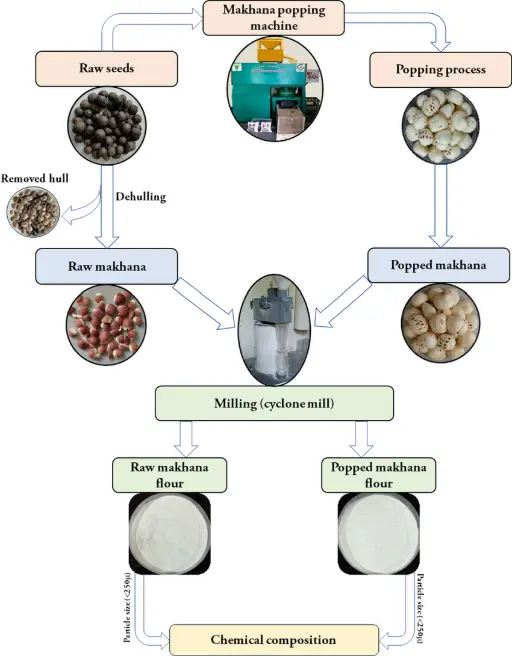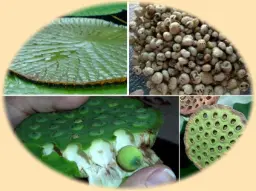What is Makhana?
Makhana, also known as fox nuts, lotus seeds, or gorgon nuts, comes from the aquatic plant Euryale ferox. Native to India and cultivated widely in Bihar, it has been a cherished snack and ceremonial food for centuries.
These puffed seeds are light, crunchy, and nutritious — commonly used in sweets, curries, and as a healthy snacking.
How is Makhana Grown?
-
Cultivation in Water Bodies
Grown in shallow ponds (0.2–2 m deep) with floating thorny leaves and vibrant purple flowers. -
Harvesting
Involves skilled workers wading into ponds to collect seeds from the muddy bottom using bamboo poles called kaara.
Processing 
A. Cleaning & Drying
- Seeds are washed, shaken using gaanja-style containers, sun-dried to around 31% moisture, then stored.
B. Grading
- Sieved through multiple layers to sort by size—ensuring uniform roasting
Roasting & Popping
-
Preheating & Tempering
Seeds are roasted in cast-iron pans or earthen pitchers at 250–320 °C, then rested for 2–3 days. -
Popping
Heated seeds are cracked manually with wooden mallets, causing them to puff into white edible puffs called lawa. -
Polishing & Packaging
After popping, seeds are smoothed in bamboo baskets, then packaged in moisture-resistant bags.
Mechanization & Quality
Modern facilities, such as those from ICAR–CIPHET, use mechanized roasting and popping to improve safety, uniformity, and hygiene — while traditional ручной methods are still valued for authenticity.
Why This Matters for You
- Authenticity & Quality: Knowing the entire journey ensures you’re getting premium, traditionally prepared Makhana.
- Health & Safety: Hygienic, graded products, with minimal intervention, retain nutritional value.
-
Ethical Sourcing: By supporting direct sourcing from Bihar farmers, we contribute to fair trade and sustainable livelihoods.
Makhana Grading Table - Important Considerations for Grading:
- "Handpicked": This term implies a manual sorting process, leading to a much higher percentage of whole, uniform, and defect-free makhanas. This significantly increases the value and is often associated with premium products.
- Uniformity: Beyond just the "suta" size, the consistency of size within a batch is a key quality indicator. A batch of 5+ Suta handpicked should have very little variation in size between individual nuts.
- Whiteness/Color: High-grade makhanas should be sparkling white or creamy white. Any yellowing or discoloration indicates lower quality or older stock.
- Texture and Crispness: Premium makhanas are light, airy, and consistently crunchy.
- Minimal Defects: High grades should have very few flat, broken, or unpopped kernels.
Grade Name | Millimeter (mm) Range (approx.) | Description | Typical Usage |
Murra | 9.5 mm - 12.7 mm | Smallest grade, may have slightly irregular shapes. Also known as "Samundha." | Economical options, kheer mix, powder, Ayurvedic preparations. |
4 Suta | 12.7 mm - 15.8 mm | Pure 4 Suta Makhana. Smaller, but still widely used. | Economical, daily cooking, flavoring, some snack mixes. |
4+ Suta | 12.7 mm - 15.8 mm | Selected 4 Suta, with a higher percentage of uniform, well-popped nuts. May contain a few slightly smaller ones. | Good for regular snacking, bulk sales, cost-effective brand packing. |
5 Suta | 15 mm - 18 mm | A popular medium size, good balance of size and quality. | Everyday snacking, general culinary use, standard brand packing. |
5+ Suta | 15 mm - 18 mm | Superior quality within the 5 Suta range. Larger, more consistent, and fewer broken pieces than standard 5 Suta. | Mainly for export oriented. Premium snacking, better brand positioning, quality-focused recipes. |
5+ Handpicked | 15 mm - 18 mm | Highest quality within the 5 Suta range. Manually sorted to ensure maximum uniformity, minimal defects (broken, discolored, flat). | High-end snack brands, gifting, gourmet cooking, where appearance is paramount. |
6 Suta | 18 mm - 21 mm | Premium market grade. Noticeably larger and more visually appealing. | Premium snacking, special occasions, upscale retail. |
6+ | > 21 mm | Extra-large, very rare, and considered top-tier. | Luxury export markets, luxury segments, gourmet chefs. |
Nutritional Information (Per 100g Serving of Makhana)
- Highlights:
- Low in fat & sodium
- Gluten-free & cholesterol-free
- Rich in fiber and essential minerals
- Great for weight management and snacking
Nutrient Amount Energy 347 kcal Protein 9.7 g Total Fat 0.1 g – Saturated Fat 0.05 g – Trans Fat 0 g Carbohydrates 76.9 g – Sugars 0.8 g – Dietary Fiber 14.5 g Sodium 7 mg Potassium 500 mg Calcium 60 mg Magnesium 96 mg Iron 1.4 mg Phosphorus 180 mg
10 Health Benefits of Makhana
-
Rich in Antioxidants
Contains flavonoids like kaempferol, which fight inflammation, aging, and chronic diseases. -
Supports Heart Health
Low in cholesterol, sodium, and saturated fat — great for maintaining cardiovascular wellness. -
Aids in Weight Management
High fiber and low calories help you feel full longer without overeating. -
Controls Blood Sugar
Low glycemic index and complex carbs make it ideal for diabetics. -
Improves Digestion
High fiber content promotes smooth bowel movement and gut health. -
Boosts Energy Naturally
Good source of slow-digesting carbs and plant-based protein. -
Strengthens Bones
Rich in calcium, magnesium, and phosphorus for bone density and strength. -
Detoxifies the Body
Supports kidney function and helps flush out toxins. -
Enhances Skin Health
Antioxidants and amino acids help repair skin and delay signs of aging. -
Supports Cognitive Function
Contains thiamine, which helps in production of acetylcholine — vital for brain health.